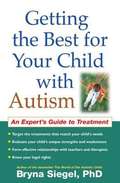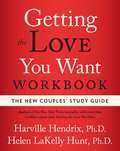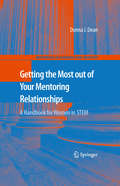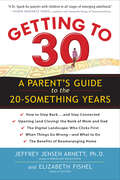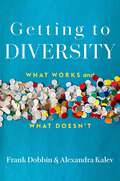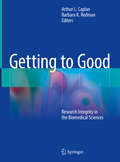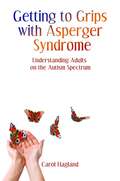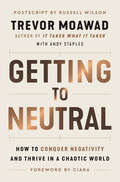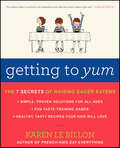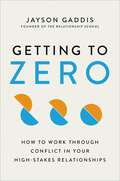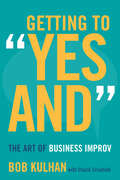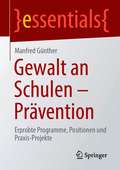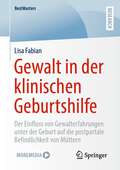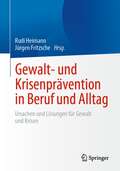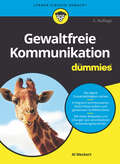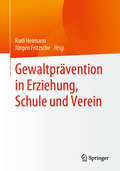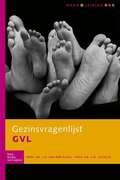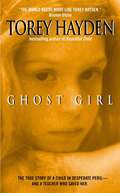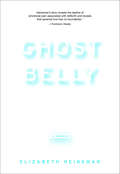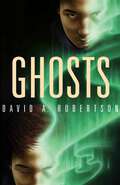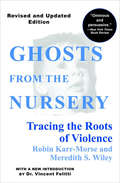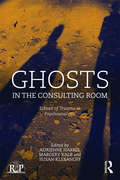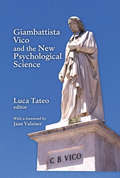- Table View
- List View
Getting the Best for Your Child with Autism
by Bryna SiegelAs the parent of a child with an autism spectrum disorder, you need an informed, caring advocate who can deftly guide you through the complex maze of treatment options. In this empowering resource, bestselling author Bryna Siegel--one of the world's leading authorities on the disorder--helps you zero in on proven strategies and tailor them to fit your child's unique needs. Like no other book, Getting the Best for Your Child with Autism shows how to get an accurate assessment of your child's strengths and weaknesses so you can develop a plan of action suited to his or her individual learning style, interests, verbal abilities, and social skills. You'll learn what services you're entitled to, how to determine what's right for your family, and ways to work effectively with doctors and school professionals. With Dr. Siegel as your ally, you can help your child learn and grow.
Getting the Love You Want Workbook: The New Couples' Study Guide
by Harville Hendrix Helen LaKelly HuntThis newly revised and updated companion study guide to the 2019 edition of the New York Times bestseller Getting the Love You Want.In 1988, Harville Hendrix, in partnership with his wife, Helen LaKelly Hunt, published a terrifically successful relationship guide called Getting the Love You Want. The book introduced thousands to their Imago Relationship Therapy, a unique healing process for couples, prospective couples, and parents, and developed into an overnight sensation. For their part, Doctors Hendrix and Hunt managed to aid scores of couples in their plight for more loving, supportive, and deeply satisfying relationships. Now, more than a decade later, this companion book picks up where its predecessor left off, delving further into relationship therapy to help transform relationships into lasting sources of love and companionship. The Getting the Love You Want Workbook is designed for the hundreds of thousands of couples who have attended Imago workshops since Getting the Love You Want hit bookstands, as well as new and curious ones seeking a practical route back to intimacy and passionate friendship. The workbook contains a unique twelve-week course (The New Couples&’ Study Guide) designed to help work through the exercises published in Part III of Getting the Love You Want. For those of us struggling to maintain our most precious relationships, the Getting the Love You Want Workbook helps us grow aware of our individual, unconscious agenda while steering us towards a more harmonious link with our loved ones that will satisfy our deepest needs.
Getting the Most out of Your Mentoring Relationships
by Donna J. DeanTraditionally, scientific research in all disciplines has demanded single-mindedness, exclusive devotion, and aggressive self-promotion. The image of the scientist in the laboratory at all hours of the night and weekend is not far from the reality sometimes demanded. Because of the structure of the science, technology, engineering, and mathematics (STEM) curricula and workplace environment, women often work up to 80 hours per week with little time for outside pursuits - let alone extracurricular reading. Yet, precisely because of these demands, it is imperative that they build solid mentoring relationships. This handbook aims to provide a quick, yet structured guide to mentoring including finding the right mentors, being a good mentee, and making the most out of today's diverse mentoring environments. A handy resource guide will be included for quick reference.
Getting to 30: A Parent's Guide to the 20-Something Years
by Elizabeth Fishel Jeffrey Jensen Arnett“This is the book parents have been waiting for”—Michael Thompson, coauthor of Raising Cain. The book that is “helpful, hopeful, and engaging”—Jeanne Brooks-Gunn, Ph.D., Columbia University. It is the book that addresses the new reality for parents of kids in their 20s and the issues that everyone in the media is talking about: When will this new generation of 20-somethings leave home, find love, start a career, settle down—grow up? And it's the book that will soothe your nerves. It’s loaded with information about what to expect and guidance on what to do when problems arise (as they probably will). In other words, this is the book parents need—Getting to 30, by Jeffrey Jensen Arnett, the world's leading authority on the post-adolescent phase he named emerging adulthood, and Elizabeth Fishel, author of Sisters and other books. As Getting to 30 shows, the road to adulthood is longer than we think—and, for parents, bumpier. It explains what’s really happening to your 18- to 29-year-old, including the story behind your child’s moods. The phenomenon of the boomerang child—and why it’s actually a good thing, for parents and kids. The new landscape of 20-something romance. And it gives all the tools parents need to deal with the challenges, from six ways to listen more than you talk, to knowing when to open (and close) the Bank of Mom and Dad while saving for retirement, to figuring out the protocol for social media. Published in hardcover as When Will My Grown-Up Kid Grow Up?, Getting to 30 includes the latest research on the optimistic and supportive attitude most parents have regarding their 20-something children.
Getting to Diversity: What Works and What Doesn’t
by Frank Dobbin Alexandra Kalev“Too many companies don’t know how to walk the walk of diversity, equity, and inclusion. Getting to Diversity shows them how.”—Lori George Billingsley, former Global Chief DEI Officer, Coca-Cola CompanyIn an authoritative, data-driven account, two of the world’s leading management experts challenge dominant approaches to increasing workplace diversity and provide a comprehensive account of what really works.Every year America becomes more diverse, but change in the makeup of the management ranks has stalled. The problem has become an urgent matter of national debate. How do we fix it? Bestselling books preach moral reformation. Employers, however well intentioned, follow guesswork and whatever their peers happen to be doing. Arguing that it’s time to focus on changing systems rather than individuals, two of the world’s leading experts on workplace diversity show us a better way in the first comprehensive, data-driven analysis of what succeeds and what fails. The surprising results will change how America works.Frank Dobbin and Alexandra Kalev draw on more than thirty years of data from eight hundred companies as well as in-depth interviews with managers. The research shows just how little companies gain from standard practice: sending managers to diversity training to reveal their biases, then following up with hiring and promotion rules, and sanctions, to shape their behavior. Almost nothing changes. It’s time, Dobbin and Kalev argue, to focus on changing the management systems that make it hard for women and people of color to succeed. They show us how the best firms are pioneering new recruitment, mentoring, and skill training systems, and implementing strategies for mixing segregated work groups to increase diversity. They explain what a difference ambitious work–life programs make. And they argue that as firms adopt new systems, the key to making them work is to make them accessible to all—not just the favored few.Powerful, authoritative, and driven by a commitment to change, Getting to Diversity is the book we need now to address constructively one of the most fraught challenges in American life.
Getting to Good: Research Integrity In The Biomedical Sciences
by Barbara K. Redman Arthur L. CaplanThis book represents the first comprehensive, gold standard reader on research integrity in the biomedical sciences. Now more than ever, the responsible conduct of research (RCR) has become critically important as new technologies affect research practices in both positive and negative ways. Since learning to do science and practicing it brings researchers into contact with a vast array of ethical issues, it is critical to know the standards and how they are evolving. Indeed, research integrity requires scientists at all levels to operate ethically in a system that supports ethical practice. This unique, foundational text covers all the relevant areas -- subject protection, research misconduct and conflict of interest as well as newly quantified concerns about research bias and non-reproducibility, as well as other unique issues. Developed by renowned experts, this compelling title discusses the full range of practices and policies that should support research that is honestly produced and disseminated. It also specifically incorporates topics noted by the National Institutes of Health as essential and required for training in RCR. Getting to Good – Research Integrity in the Biomedical Sciences is a major contribution to the literature on bioethics and will serve as an invaluable resource for all researchers, students, administrators and professionals interested in research ethics and integrity.
Getting to Grips with Asperger Syndrome
by Carol HaglandGetting to Grips with Asperger Syndrome is a practical, problem-solving guide for those caring for or supporting an adult with Asperger Syndrome (AS). It will help them understand the condition and the difficulties it may cause, so that they can offer support in the most beneficial way. The book explains what AS is and why certain behaviours frequently occur: such as anxiety, fear of change and unusual sensitivities. Once behaviours and reactions are understood, many of the apparent problems become less troublesome, and difficulties can be avoided or easily-resolved. Practical strategies are offered to combat problems that may arise, and common issues that specifically occur with individuals diagnosed later in life are addressed. Easy-to-read and accessible, this book is a useful reference for friends and family of individuals with AS, as well as health and social care staff and students, whatever the level of training and experience.
Getting to Neutral: How to Conquer Negativity and Thrive in a Chaotic World
by Trevor Moawad Andy StaplesForeword by CiaraIn this breakthrough book, the author of Wall Street Journal bestseller It Takes What It Takes provides life-changing, step-by-step guidance on how to successfully navigate adversity and defeat negativity by downshifting to neutral thinking. It’s easy to be positive when everything is coming up roses. But what happens when life goes sideways? Many of us lapse into a self-defeating negative spiral that makes it hard to accomplish anything. Getting to Neutral is a step-by-step guide that shows readers how to use mental conditioning coach Trevor Moawad’s innovative motivational system to defeat negativity and thrive.Neutral thinking is a judgment-free, process-oriented approach that helps us coolly assess situations in high-pressure moments. Moawad walks readers through how to downshift to neutral no matter how dire the situation. He shows us how to behave our way to success, how to determine and practice our values in a neutral framework, and how to surround ourselves with a team that helps us to stay neutral. Filled with raw, inspiring stories of how Trevor navigated health challenges with neutral thinking as well as insights drawn from some of the world’s best athletes, coaches, and leaders, Getting to Neutral will help readers learn to handle even the most complex and turbulent situations with calm, clarity, and resolve.
Getting to YUM: The 7 Secrets of Raising Eager Eaters
by Karen Le BillonFrom the author of the popular French Kids Eat Everything, a simple, easy and surprisingly fun way to change dinnertime reactions from YUCK to YUM.Are mealtimes with your kids a source of frustration? Ever wonder how on earth to get them to eat the recommended 5 servings of fruits and veggies per day (or even per week)?Getting to YUM is a practical and engaging guide for parents eager to get past their children's food resistance—or avoid it altogether. It introduces 7 Secrets of Raising Eager Eaters (Secret 1: Teach your child to eat, just like you teach them to read! or Secret 6: Teach me to do it myself: kid participation is every parent's secret weapon).Karen Le Billon, author of French Kids Eat Everything, coaches readers through the process of taste training, including strategies, games and experiments that will encourage even reluctant eaters to branch out. Over 100 delicious, kid-tested, age-appropriate recipes lead families step-by-step through the process of "learning to love new foods," enabling kids to really enjoy the foods we know they should be eating.Wise and compelling, Getting to YUM is grounded in revolutionary new research on the science of taste. Packed full of observations from real-life families, it provides everything parents need to transform their children—from babies to toddlers to teens—into good eaters for life.
Getting to Zero: How to Work Through Conflict in Your High-Stakes Relationships
by Jayson GaddisThe counselor, teacher, and founder of The Relationship School reveals the origins of conflict styles, and how to stop avoiding and resolve conflict in relationships with loved ones.Conflicts in our closest relationships are scary because so much is at stake. If the conflict doesn't go well, we could lose our marriage, our family or our job, all connected to our security and survival. So we do just about anything not to lose those relationships, including avoid conflict, betraying ourselves or becoming dishonest. Unresolved conflict affects every single aspect of our lives, from self-confidence to physical and mental health.Jayson Gaddis is a personal trainer for relationships and one of the world&’s leading authorities on interpersonal conflict. For almost two decades, Gaddis has helped individuals, couples, and teams get to the bottom of their deepest conflicts. He helps people see the wisdom in conflict and how to get to zero—which means we have successfully worked through our conflict and have nothing in the way of a good connection.In Getting to Zero, Gaddis shows the reader how to stop running away from uncomfortable conversations and instead learn how to work through them. Through funny personal stories, uncomfortable examples, and effective tools and skills, he shows the reader how to move from disconnection to connection, acceptance, and understanding. This method upgrades the old tired and static conflict resolution approaches and offers a fresh, street-level, user-friendly road map on exactly how to work through conflict with the people you care most about.
Getting to “Yes And”: The Art of Business Improv
by Chuck Crisafulli Bob KulhanAmidst the deluge of advice for businesspeople, there lies an overlooked tool, a key to thriving in today's fast-paced, unpredictable environment: improvisation. In Getting to "Yes And" veteran improv performer, university professor, CEO, and consultant Bob Kulhan unpacks a form of mental agility with powers far beyond the entertainment value of comedy troupes. Drawing on principles from cognitive and social psychology, behavioral economics, and communication, Kulhan teaches readers to think on their feet and approach the most typical business challenges with fresh eyes and openness. He shows how improv techniques such as the "Yes, and" approach, divergent and convergent thinking, and focusing on being present can translate into more productive meetings, swifter decisions, stronger collaboration, positive conflict resolution, mindfulness, and more. Moving from the individual to the organizational level, Kulhan compiles time-tested teaching methods and training exercises into an instrumental guide that readers can readily implement as a party of one or a company of thousands.
Gewalt an Schulen - Prävention: Erprobte Programme, Positionen und Praxis-Projekte (essentials)
by Manfred GüntherDer spezielle Zugang zum Thema Gewalt an Schulen – Prävention in diesem essential besteht darin, in aller Kürze zu zeigen, welche schulbezogenen Präventionsprogramme heute, nach den Erfahrungen aus Erfurt und Winnenden, in den Bundesländern eingesetzt werden und welche davon evaluierte „good practice“ sind. Denn unentschieden ist, welche entwickelten Anti-Bullying-Pakete und welche Art Amok-Vorsorge möglichst überall zu implementieren sind. Was könnte anderseits in der „Eigenverantwortlichen Schule“ in Kooperation mit Schulsozialarbeit dezentral beschlossen und umgesetzt werden? Der Autor wirkte an Brennpunktschulen in Berlin-Kreuzberg und empfiehlt dringend Notfallpläne, „Mehrebenen-Projekte“ sowie Krisenteams.
Gewalt in der klinischen Geburtshilfe: Der Einfluss von Gewalterfahrungen unter der Geburt auf die postpartale Befindlichkeit von Müttern (BestMasters)
by Lisa FabianInwieweit beeinflusst die Geburtserfahrung das weitere Leben von Müttern? Die vorliegenden Forschungsergebnisse der postpartalen Psychologie lassen die Geburtserfahrung in einem völlig neuen Lichte erscheinen. Die Geburtserfahrung als solche und das Erleben der Mütter in dieser Situation haben nach diesen Erkenntnissen weitreichenden Einfluss auf das postpartale psychische Empfinden der Mütter und die Beziehung zum Kind.Die Autorin thematisiert unter anderem die psychischen Folgen eines belastenden Geburtserlebnisses und gibt Hinweise zu Handlungsempfehlungen für geburtshilfliches Personal.
Gewalt- und Krisenprävention in Beruf und Alltag: Ursachen und Lösungen für Gewalt und Krisen
by Rudi Heimann Jürgen FritzscheDer Herausgeberband gibt einen anwenderorientierten Überblick zu Ursachen und Entwicklungen von Bedrohungen, Gewalt und daraus entstehender Krisen im beruflichen Kontext und im Alltag. Ein interdisziplinäres Autorenteam stellt neben den Grundlagen die wichtigsten Methoden zur Bewältigung sich entwickelnder und bereits offener Gewalt- und Krisensituationen vor. Der Schwerpunkt liegt im Anwendungsteil auf angemessener konfliktfreier Lösung und der konsequenten Verfolgung alternativer Möglichkeiten, wenn eine konfliktfreie Bewältigung nicht mehr möglich ist. Sicherheitskonzepten und praktikablen Deeskalationsmodellen wird ebenso wie massiven Krisen ein Platz eingeräumt.Die Zielgruppen sind Führungskräfte und Mitarbeitende in öffentlichen Verwaltungen, Justiz, Schulen, Geldinstituten, im Gesundheitswesen, öffentlichen Personennahverkehr oder in vergleichbaren Einrichtungen, Verantwortliche wie Sicherheits- und Präventionsbeauftragte in diesen Bereichen, Trainer für Sicherheitsthemen und Interessierte im privaten Umfeld.Die Herausgeber sind Rudi Heimann, Leitender Polizeidirektor, Experte für Gewaltschutz und Krisenbewältigung, Keynote Speaker und Leiter einer Zentralen Ausländerbehörde, sowieDr. Jürgen Fritzsche, sportwissenschaftlicher Berater, Coach und Gewaltschutztrainer (EXperts for TRAining), ehemaliger Bundeslehrwart des Deutschen Karateverbandes, international tätiger Dozent und Technischer Direktor des luxemburgischen Karateverbandes.Empfehlung der DGUV“Im vorliegenden Buch ist es gelungen, die aktuellen Erkenntnisse zum Thema Gewalt umfassend und gleichzeitig alltagsnah aufzubereiten. Eine besondere Stärke liegt in der Interdisziplinarität […], die Einblicke in verschiedenste wissenschaftliche Bereiche gewährt. Klare Handlungsempfehlungen schützen bei einem potentiell gewalttätigen Konflikt vor einer weiteren Eskalation.”Dr. Stefan HussyHauptgeschäftsführer der Deutschen Gesetzlichen Unfallversicherung (DGUV)
Gewaltfreie Kommunikation für Dummies (Für Dummies)
by Al WeckertMöchten auch Sie einfühlsamer kommunizieren? Al Weckert erläutert Ihnen die vier Schritte der Gewaltfreien Kommunikation nach Marshall B. Rosenberg: urteilsfreie Beobachtung, Gefühle, Bedürfnisse, Bitten, die eine wertschätzende Kommunikation mit dem Gegenüber ermöglichen. Sie erfahren anhand vieler Beispiele und Übungen, wie die Gewaltfreie Kommunikation im Beruf, in der Partnerschaft und der Erziehung Konflikte entschärft und hilft, Lösungen zu finden, in denen die Belange aller Beteiligten berücksichtigt werden. Außerdem gibt er denen, die Gewaltfreie Kommunikation weitergeben wollen, zahlreiche Hinweise zur Aus- und Weiterbildung.
Gewaltprävention in Erziehung, Schule und Verein
by Rudi Heimann Jürgen FritzscheDie Sicherheit von Kindern im Zusammenhang mit dem Schutz vor Übergriffen und Gewalt ist ein Grundbedürfnis unserer Gesellschaft. Dieser Herausgeberband gibt einen präzisen Überblick zur Sozialerziehung von Kindern und Jugendlichen für alle Verantwortlichen, die im Rahmen ihrer beruflichen, ehrenamtlichen oder erzieherischen Tätigkeit die notwendigen Impulse setzen wollen und daran interessiert sind, wie sie diese erfolgreich vermitteln. Das Handbuch umfasst einen Grundlagen- und Präventionsteil.
Gezinsvragenlijst (GVL) handleiding
by Prof. dr. van der Ploeg Prof. dr. ScholteDoel van de testDe GVL meet de kwaliteit van gezins- en opvoedingsomstandigheden van kinderen in de leeftijd van 4 t/m 18 jaar. Gezinsomstandigheden hebben grote invloed op de gedrags- en emotionele ontwikkeling van kinderen en jongeren. Wanneer zich in een gezin problemen voordoen, kan dit de sociaal emotionele ontwikkeling van kinderen ernstig verstoren. In de jeugdzorg is men er inmiddels van doordrongen dat het behandelen van alleen de jeugdige niet voldoende is, maar dat ook altijd aandacht voor het gezin noodzakelijk is. Gezinsvragenlijsten screenen de opvoedingsinvloed van het gezin meestal alleen via de ouder-kind relatie. Het gezin bestaat echter uit meerdere relaties: ook de relatie tussen de ouders onderling en tussen het gezin en haar omgeving zijn onderdeel van het gezinssysteem. De Gezinsvragenlijst meet deze meervoudige gezinsrelaties en screent zowel het opvoedgedrag van de ouders als het functioneren van het gezin als geheel. Afname brengt aan het licht waar het gezin eventueel tekort schiet, wat de risico’s zijn op problematisch gedrag bij een kind en waar de mogelijke oorzaken liggen van problemen in het gezin. Afname van de GVL verschaft aanknopingspunten voor interventies.ToepassingsmogelijkhedenScreening: screent het gezinsfunctioneren en spoort risicovolle pedagogische en gezinsomstandigheden op bij gezinnen met schoolgaande kinderen in het gewoon basisonderwijs, het speciaal basisonderwijs en het voortgezet onderwijs. Periodieke afname brengt het beloop van risicovolle gezins- en opvoedingsomstandigheden in beeld. Diagnose: bepaalt of doorverwijzing naar jeugdzorg nodig is. Geeft aanknopingspunten voor gezinsinterventies. Bepaalt de aard en de ernst van problemen in de gezins- en opvoedingssituatie. Behandeling: geeft aanknopingspunten voor interventies. Evalueert de voortgang en de effectiviteit van interventies. Wat meet de GVL?De GVL screent de relaties tussen de ouders en het kind, tussen de ouders onderling en tussen het gezin en haar omgeving. Daarnaast screent de GVL de context waarbinnen deze relaties zich afspelen: de organisatie van het gezin en de gezinsstructuur. De GVL bestaat uit vijf basisschalen die samen het totale gezinsfunctioneren vertegenwoordigen: • responsiviteit (de opvoedingsrelatie van de ouders met het kind)• communicatie (de communicatie van de ouders met het kind) • organisatie (de gezinscontext waarbinnen de gezinsrelaties plaatsvinden)• partnerrelatie (de onderlinge relatie tussen de ouders)• sociaal netwerk (de relaties van het gezin met de omgeving)Voor wie?De GVL wordt ingevuld door de ouders of opvoeders van het kind, of door personen die het kind en het gezin goed kennen. Maatschappelijk werkers, groepsleiders, psychologen, orthopedagogen en andere professionele hulpverleners kunnen de uitslagen van de test gebruiken ter taxatie van de gezins- en opvoedingssituatie van kinderen en gezinnen. Testuitslagen mogen echter alleen worden geïnterpreteerd door psychodiagnostisch geschoolde personen.Afname en scoringDe GVL bestaat uit 45 vragen. De afname duurt circa 30 minuten. Het invullen en scoren kan enerzijds handmatig plaatsvinden. U kunt de GVL ook geautomatiseerd afnemen en scoren met behulp van Testweb.Belangrijk: u kunt deze test alleen afnemen indien u over de GVL Handleiding beschikt.NormenInterpretatie van de scores vindt plaats door de scores van individuele respondenten te vergelijken met normen die het onderscheid tussen wel en geen problematiek weergeven. Voor de interpretatie worden in de handleiding de volgende normgegevens verstrekt:• Algemene bevolking• Klinische gezinnenMaterialen• GVL handleiding• GV
Ghost Girl: The True Story of a Child in Desperate Peril - and a Teacher Who Saved Her
by Torey L. HaydenRecounting her experiences with Jadie, a student in her class, a teacher describes how she persuaded Jadie to break her silence and reveal the family secrets that were plaguing her. The true story of a child who refused to speak and the teacher who finally got through to her--uncovering a dark history of child abuse and possible satanic rituals--from the bestselling author of One Child. "A testament to the powers of caring and commitment."--Publishers Weekly.
Ghostbelly
by Elizabeth HeinemanEveryone loves to blame a mother for making the "wrong" choices, and Elizabeth Heineman makes plenty of unpopular ones: being of advanced maternal age, having a home birth with a midwife, communing with her dead baby. In Ghostbelly, Heineman's brave, disarming, and stunning memoir, she recounts her indescribable grief after delivering a stillborn son, her shocking and intimate bonding with the baby's body before the burial, and the impossible task of saying goodbye.In 2008 Elizabeth McCracken's memoir broke the silence surrounding stillbirth, which account for one in 160 pregnancies in the United States. Now Ghostbelly provides a searing tale of motherhood, the need to invent our own rituals of grieving, and the unexpected space we occupy when birth and death coincide.
Ghosts (The Reckoner)
by David A. RobertsonMysterious murders, shadowy figures, and high school. Life can be hard; death can be harder.Cole Harper is dead. Reynold McCabe is alive and free. Mihko Laboratories has reopened the research facility and works to manufacture and weaponize the illness that previously plagued Wounded Sky. People are missing, and the community has been quarantined. What deal did Eva strike with Choch? Who will defeat Reynold and Mihko? Time is running out.
Ghosts (The Reckoner)
by David A. RobertsonMysterious murders, shadowy figures, and high school. Life can be hard; death can be harder.Cole Harper is dead. Reynold McCabe is alive and free. Mihko Laboratories has reopened the research facility and works to manufacture and weaponize the illness that previously plagued Wounded Sky. People are missing, and the community has been quarantined. What deal did Eva strike with Choch? Who will defeat Reynold and Mihko? Time is running out.
Ghosts (The Reckoner)
by David A. RobertsonMysterious murders, shadowy figures, and high school. Life can be hard; death can be harder.Cole Harper is dead. Reynold McCabe is alive and free. Mihko Laboratories has reopened the research facility and works to manufacture and weaponize the illness that previously plagued Wounded Sky. People are missing, and the community has been quarantined. What deal did Eva strike with Choch? Who will defeat Reynold and Mihko? Time is running out.
Ghosts from the Nursery: Tracing the Roots of Violence
by Robin Karr-Morse Meredith S. Wiley Dr Vincent FelittiThis new, revised edition incorporates significant advances in neurobiological research over the past decade, and includes a new introduction by Dr. Vincent J. Felitti, a leading researcher in the field. When Ghosts from the Nursery: Tracing the Roots of Violence was published in 1997, it was lauded for providing scientific evidence that violence can originate in the womb and become entrenched in a child’s brain by preschool. The authors’ groundbreaking conclusions became even more relevant following the wave of school shootings across the nation including the tragedy at Columbine High School and the shocking subsequent shootings culminating most recently in the massacre at Sandy Hook Elementary School in Newtown, Connecticut. Following each of these media coverage and public debate turned yet again to the usual suspects concerning the causes of violence: widespread availability of guns and lack of mental health services for late-stage treatment. Discussion of the impact of trauma on human life-especially early in life during chemical and structural formation of the brain-is missing from the equation. Karr-Morse and Wiley continue to shift the conversation among parents and policy makers toward more fundamental preventative measures against violence.
Ghosts in the Consulting Room: Echoes of Trauma in Psychoanalysis (Relational Perspectives Book Series)
by Adrienne Harris Margery Kalb Susan KlebanoffGhosts in the Consulting Room: Echoes of Trauma in Psychoanalysis is the first of two volumes that delves into the overwhelming, often unmetabolizable feelings related to mourning. The book uses clinical examples of people living in a state of liminality or ongoing melancholia. The authors reflect on the challenges of learning to move forward and embrace life over time, while acknowledging, witnessing and working through the emotional scars of the past. Bringing together a collection of clinical and theoretical papers, Ghosts in the Consulting Room features accounts of the unpredictable effects of trauma that emerge within clinical work, often unexpectedly, in ways that surprise both patient and therapist. In the book, distinguished psychoanalysts examine how to work with a variety of ‘ghosts’, as they manifest in transference and countertransference, in work with children and adults, in institutional settings and even in the very founders and foundations of the field of psychoanalysis itself. They explore the dilemma of how to process loss when it is unspeakable and unknowable, often manifesting in silence or gaps in knowledge, and living in strange relations to time and space. This book will be of interest to psychotherapists and psychoanalysts, as well as social workers, family therapists, psychologists, and psychiatrists. It will appeal to those specializing in bereavement and trauma and, on a broader level, to sociologists and historians interested in understanding means of coping with loss and grief on both an individual and larger scale basis.
Giambattista Vico and the New Psychological Science (History And Theory Of Psychology Ser.)
by Luca TateoGiambattista Vico (1668�1744) was an Italian philosopher, rhetorician, and historian. As one of the great thinkers of the Enlightenment, he exerted tremendous influence on the social sciences. He was the first to stress cultural and linguistic dimensions in the development of both the human mind and social institutions. Although his ideas on the relationship between mind and culture and his epistemology have inspired the work of many scholars in psychology, his sizeable influence has been scarcely acknowledged. The volume is organized in two sections. The first locates Vico in his historical context and in the landscape of contemporary human and social sciences. The second part presents those of Vico's concepts that seem promising for the development of a new way of looking at psychological phenomena. In the book's conclusion, Luca Tateo gathers the ideas of the volume's contributors to suggest future development of the psychological sciences. This book aims to show how Vico's insights can inspire future research in the psychological sciences. It collects multidisciplinary contributions of leading international scholars that draw upon the thought of this original thinker. Collectively, the contributors remind us of the legacy and continuing influence of this inspiring historical figure.
